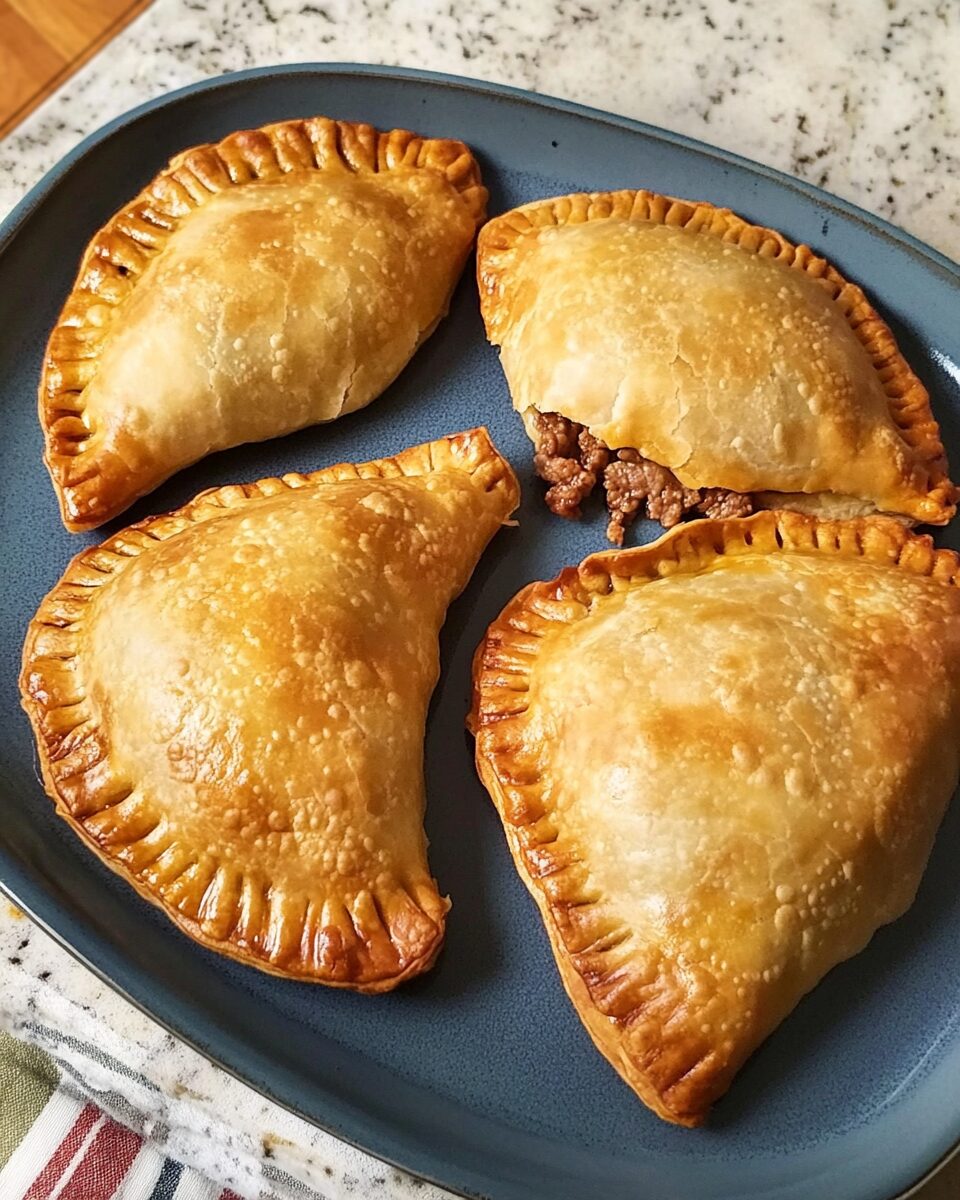The aroma of sizzling ground beef seasoned with sofrito, sazón, and garlic fills the kitchen as these traditional beef empanadas come together. Encased in a golden, flaky pastry, the savory filling is enhanced by hints of briny olives and rich tomato sauce.
These empanadas are a Latin American favorite for good reason. Whether you’re prepping them for a family gathering or craving a satisfying snack, each bite delivers warmth, crunch, and mouthwatering flavor. Serve them with a side of salsa or enjoy solo—either way, they’re irresistible.
Full Recipe:
-
1 tablespoon olive oil
-
1 pound ground beef
-
1 small onion, chopped
-
1/2 cup tomato sauce
-
1/4 cup chopped pimento-stuffed green olives
-
2 tablespoons sofrito
-
1 packet sazón with coriander and annatto
-
1 clove garlic, minced
-
1/2 teaspoon dried oregano
-
Fresh ground black pepper, to taste
-
1 (14-ounce) package empanada pastry disks (Goya Discos), thawed
-
Water, for sealing
-
Corn oil, for frying
Directions:
-
In a large skillet, heat olive oil over medium heat. Add ground beef and cook, stirring occasionally, until browned and crumbly, about 10 minutes.
-
Stir in chopped onion and cook until softened, about 5 minutes.
-
Add tomato sauce, olives, sofrito, sazón, garlic, oregano, and pepper. Lower heat and simmer for about 15 minutes until mixture thickens.
-
Lightly flour a surface and roll out empanada disks slightly.
-
Spoon 1 tablespoon of the meat mixture into the center of each disk. Moisten the edges with water, fold into a half-moon, and seal by pinching or pressing with a fork.
-
In a deep fryer or large saucepan, heat 2 1/2 inches of corn oil to 350°F (175°C). Fry empanadas in batches until golden brown, flipping once—about 4 to 6 minutes.
-
Transfer to paper towels to drain and serve warm.
Prep Time: 25 minutes | Cooking Time: 25 minutes | Total Time: 50 minutes
Kcal: 290 kcal | Servings: 10 empanadas
Introduction to Beef Empanadas
Beef empanadas are one of the most beloved and culturally rich dishes across Latin America and beyond. These golden, crispy turnovers are filled with savory beef mixtures that reflect centuries of culinary fusion, colonization, and migration. Although beef empanadas may seem simple on the surface—just dough wrapped around a meat filling—their preparation, seasoning, and presentation vary widely from country to country, and even from kitchen to kitchen. For food lovers, empanadas are more than just a snack or appetizer; they are comfort food, party staples, and a symbol of tradition passed through generations.
Empanadas offer a culinary bridge between old-world influences and modern convenience. This particular beef empanada recipe is inspired by Puerto Rican and Dominican traditions, incorporating vibrant flavors like sofrito, sazón, and olives into the meat filling. These ingredients give the empanadas a distinctive Caribbean profile, elevating them from ordinary meat pies to deeply flavorful delights.
Historical and Cultural Background
The word “empanada” comes from the Spanish verb empanar, meaning “to wrap or coat in bread.” Originating in Galicia, Spain, empanadas were introduced to Latin America by Spanish colonizers in the 16th century. Since then, they have evolved to suit local ingredients, preferences, and traditions across the Americas.
In Puerto Rico and the Dominican Republic, empanadas—often called “pastelillos”—are typically fried rather than baked, and filled with beef that’s been cooked down with a rich blend of tomato sauce, onions, garlic, and regional staples like sofrito and sazón. This Caribbean take distinguishes itself from the Argentine or Chilean varieties, which may feature hard-boiled eggs, raisins, or even olives in a more subtle spiced filling.
Empanadas have also become popular in the United States, particularly in cities with large Hispanic populations. Thanks to frozen pastry disks like Goya Discos, home cooks now have a shortcut to enjoy this dish without making the dough from scratch. This accessibility has contributed to a resurgence of empanada popularity, with creative fillings and fusion versions appearing in food trucks, bakeries, and restaurants nationwide.
Common Variations of Empanadas
Empanadas are incredibly versatile, and the beef variety has inspired dozens of regional adaptations. In Argentina, for example, the filling might include hard-boiled eggs and green olives, while in Mexico, ground beef is often seasoned with cumin and chili powder for a spicier kick. Chilean empanadas are typically baked and larger in size, often served with a side of pebre, a Chilean salsa made of tomatoes, onions, cilantro, and vinegar.
Other fillings include shredded chicken, pulled pork, cheese, vegetables, or even seafood. Sweet versions exist too—filled with guava and cream cheese, pumpkin, or dulce de leche. Empanadas can be made gluten-free, vegetarian, or even vegan with a few ingredient swaps, proving that this dish is as adaptable as it is delicious.
What remains consistent across these variations is the love and care that goes into making them. Whether for holidays, birthdays, or casual weeknight dinners, empanadas offer a sense of home and hospitality.
Tips for Making the Best Beef Empanadas
Even though the process may seem straightforward, a few tips can elevate your empanadas from good to great:
-
Flavor Depth: Use a well-seasoned filling. Don’t skimp on the sofrito and sazón—these add complexity and depth that are essential to the dish.
-
Moisture Balance: Avoid overly wet fillings, which can cause the empanadas to leak or become soggy. Simmer the beef mixture until most of the liquid evaporates.
-
Seal it Right: Ensure the edges are properly sealed to prevent leaks during frying. Pressing with a fork not only secures the seal but adds a decorative touch.
-
Oil Temperature: Fry at 350°F (175°C). Too hot and the outside burns before the inside heats; too cool and they absorb excess oil.
-
Drain Excess Oil: Always place fried empanadas on a paper towel-lined tray to absorb oil and maintain crispiness.
Empanadas are also highly freezer-friendly. You can freeze them either before or after cooking. If freezing raw, lay them flat on a tray until solid, then transfer to a sealed bag or container. When ready to cook, fry straight from frozen—no need to thaw.
Serving Suggestions and Pairings
Beef empanadas are incredibly satisfying on their own, but they pair beautifully with a range of accompaniments. A fresh side salad with citrus vinaigrette balances the richness of the fried dough. Dipping sauces like garlic aioli, chimichurri, or a simple spicy ketchup can enhance the flavor profile even further.
They’re ideal for party platters, lunchboxes, and picnic baskets. Their portable nature makes them great for events, road trips, or even late-night snacks. They also serve as an excellent appetizer before a Latin-themed dinner or as the star of a casual family meal.
Beverage pairings can range from a refreshing lime soda or iced tea to more festive options like sangria, mojitos, or a cold cerveza.
Cultural Significance and Family Traditions
Empanadas are a food that brings people together. Many families have their own “secret recipe,” often passed down from grandparents who learned it from their parents. In many households, making empanadas is a group activity. Children might help with folding and sealing, while adults handle the filling and frying. This collaborative spirit adds emotional value to the dish—it’s about more than just taste; it’s about tradition, identity, and togetherness.
Holidays like Christmas, New Year’s Eve, and birthdays often feature trays of empanadas alongside other traditional foods. They’re also associated with street food culture, offering a quick, hot meal that’s full of flavor and heart.
Modern Twists on a Classic Dish
Today’s cooks are adding their own spin to classic beef empanadas. Fusion versions might include Korean bulgogi beef, barbecue brisket, or curry-seasoned lamb. Plant-based alternatives are also on the rise, using meat substitutes or hearty vegetables like lentils, mushrooms, or jackfruit.
The dough itself can also be changed up—whole wheat, gluten-free, or even sweet pastry doughs are gaining popularity. Air-frying is another modern twist that reduces oil while preserving crunch.
Food bloggers, chefs, and home cooks alike are embracing this culinary canvas, showcasing just how timeless and versatile empanadas can be.
Conclusion
Beef empanadas embody everything that makes comfort food so special: rich history, family ties, bold flavor, and customizable flexibility. Whether you grew up eating them or are just discovering them now, they offer a sensory experience that’s both nostalgic and novel. From their golden, flaky crust to their deeply seasoned filling, these turnovers are a testament to the enduring power of food to connect us across cultures and generations.
With their increasing popularity and adaptability, empanadas have found a home on the global stage, yet they remain rooted in the traditions that made them iconic. Whether you stick to the classic beef version or venture into fusion territory, one thing’s for certain—once you taste a well-made empanada, it’s hard to stop at just one.






